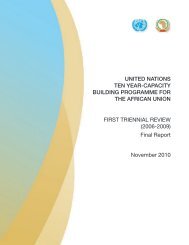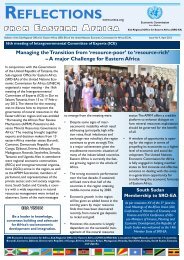Tool kit for Gender and Agriculture - Economic Commission for Africa
Tool kit for Gender and Agriculture - Economic Commission for Africa
Tool kit for Gender and Agriculture - Economic Commission for Africa
Create successful ePaper yourself
Turn your PDF publications into a flip-book with our unique Google optimized e-Paper software.
• Contributes to the policy discussion<br />
• Is followed through in implementation reviews<br />
• Is explicitly reflected in the design of projects.<br />
E. <strong>Gender</strong> Issues in <strong>Agriculture</strong> Projects<br />
30<br />
Improving <strong>Agriculture</strong> through <strong>Gender</strong> Analysis<br />
Programs <strong>and</strong> projects that ignore gender-specific barriers to resources, opportunities,<br />
<strong>and</strong> benefits risk excluding a large proportion of farmers <strong>and</strong> the farming community.<br />
For example, studies of structural adjustment have found that gender differences have<br />
hindered women from responding to incentives.<br />
It is never too early to include a gender perspective. The earlier a gender perspective<br />
is included, the greater will be the benefits. For example, the Asia <strong>and</strong> <strong>Africa</strong><br />
regions in the World Bank systematically review initial executive project summaries to<br />
identify projects that would benefit from gender analysis. Projects with good potential,<br />
serious risk, or need of support from gender specialists are monitored throughout<br />
preparation <strong>and</strong> guidance, <strong>and</strong> technical inputs are offered as needed. At the same time,<br />
no point exists in the project cycle when it is too late to consider gender issues. Even at<br />
project completion, gender analysis can help explain success or failure <strong>and</strong> draw useful<br />
lessons <strong>for</strong> future interventions.<br />
1. Project Preparation <strong>and</strong> Appraisal<br />
The aim of ensuring attention to gender when designing a project <strong>and</strong> choosing interventions<br />
is to promote project objectives <strong>and</strong> increase efficiency. The key ingredient<br />
<strong>for</strong> successful project preparation is underst<strong>and</strong>ing men’s <strong>and</strong> women’s roles in farming,<br />
their needs, <strong>and</strong> how these needs can best be satisfied. <strong>Gender</strong>-related project interventions<br />
can serve as mechanisms <strong>for</strong> achieving different outcomes, such as, to:<br />
• Increase project efficiency<br />
• Increase borrower <strong>and</strong> community ownership of the project<br />
• Overcome gender-based constraints that hamper productivity<br />
• Increase gender equity in income or income-earning opportunities, <strong>for</strong> example,<br />
credit or microprojects targeting women<br />
• Reduce the time or energy women spend on labor-intensive tasks, <strong>for</strong> example,<br />
rural infrastructure<br />
• Promote more gender-balanced access to project activities or factors of production<br />
• Promote men’s <strong>and</strong> women’s participation <strong>and</strong> decisionmaking at the community<br />
level<br />
• Strengthen institutions <strong>and</strong> increase gender awareness<br />
• Collect background data <strong>and</strong> in<strong>for</strong>mation.<br />
The main focus of the project⎯its geographic area, commodity, specific target<br />
group, or introduction of private extension⎯is chosen on agronomic <strong>and</strong> economic







